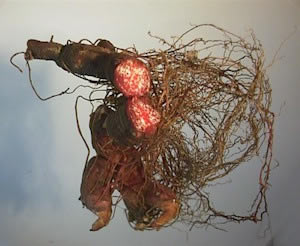Bloodroot (Sanguinaria canadensis) is a perennial herb in the poppy family. Grows primarily in North America and in India. This herb produces blood-red sap from its fresh roots. The rhizomes include alkaloids, responsible for different pharmacological effects. The main bioactive components of bloodroot are alkaloids, mainly sanguinarine. Fresh bloodroot sap or an infusion of the root can be applied externally to treat eczema, warts, ringworm, ulcers, and benign skin tumors.
Bloodroot Uses
 Bloodroot was included in the United States Pharmacopoeia from 1820 to 1926 as an botanical medication. The important component of bloodroot is sanguinarine, an alkaloid that indicates anticancer, antiangiogenic, anti-inflammatory, antimicrobial, anti-fungal, antimicrotubule and anesthetic effects. Sanguinaria canadensis used as an coughs, sore throats, antiseptic, emetic and cathartic to treat such conditions as skin cancer, inflammation and infection. It has also been used on warts, ringworm, nasal polyps, and periodontal infections, gingivitis, and plaque. Bloodroot (sanguinarine) exhibits antiplatelet activities and decreases platelet thromboxane production. Also, in a research reported in the Journal of Herbs, Spices and Medicinal Plants in 2009 bloodroot were found to modulate and stimulate human immune cells.
Bloodroot was included in the United States Pharmacopoeia from 1820 to 1926 as an botanical medication. The important component of bloodroot is sanguinarine, an alkaloid that indicates anticancer, antiangiogenic, anti-inflammatory, antimicrobial, anti-fungal, antimicrotubule and anesthetic effects. Sanguinaria canadensis used as an coughs, sore throats, antiseptic, emetic and cathartic to treat such conditions as skin cancer, inflammation and infection. It has also been used on warts, ringworm, nasal polyps, and periodontal infections, gingivitis, and plaque. Bloodroot (sanguinarine) exhibits antiplatelet activities and decreases platelet thromboxane production. Also, in a research reported in the Journal of Herbs, Spices and Medicinal Plants in 2009 bloodroot were found to modulate and stimulate human immune cells.
Researchers have isolated, sanguinarine, as the anti-cancer constituent. Sanguinarine, is also found in the greater celandine. In the 1800s, bloodroot was used as an ointment on breast tumors. Sanguinaria canadensis and zinc chloride are two agents that are used as part of the Mohs chemosurgery fixed-tissue technique. When mixed with zinc oxide, blood root creates a corrosive paste that digests skin tissue. Allopathic use of bloodroot as an escharotic (Escharotic therapies are localized treatments utilizing herbs that are corrosive or caustic. Corrosive salves are usually referred to as ‘escharotics’ because they produce a thick, dry scab named an ‘eschar’ on the skin.) for treating skin cancers was popularized by Frederick Mohs, who used a bloodroot paste to assist in the demarcation of the lesion, allowing a targeted surgical excision. It is a combined of blood root and zinc chloride and is known as “Mohs chemosurgery,” after F. Mohs, who invented the method. Scientists from University of Wisconsin have shown that bloodroot (sanguinarine) possesses powerful proapoptotic and antiproliferative effects against human epidermoid carcinoma A431 cells, immortalized human HaCaT keratinocytes, androgen-unresponsive human prostate carcinoma DU145 cells and human prostate carcinoma LNCaP cells. Nevertheless; the effect of bloodroot needs more research before it is approved as a therapeutic cure for cancer. (The FDA includes bloodroot on the list of ‘Fake Cancer Cures‘ that consumers should avoid.)
Sanguinarine, has been used as a toothpaste for mouthrinse ingredient. Some studies have shown that mouthwash containing zinc and sanguinarine is effective in reducing plaque formation. It acts as an antiseptic that avoids bacteria from forming plaque on teeth. A study reported in 2005 shown that a toothpaste containing sanguinarine and fluoride helped to avoid dental cavities better than just fluoride. Small proportions of sanguinarine have been approved by the US Food and Drug Administration for use in toothpastes to help tussle gingivitis. In a announcement from 2003, the FDA Dental Plaque Subcommittee of the Nonprescription Drugs Advisory Committee concluded “…that sanguinaria extract at 0.03-0.075% concentration is safe, but there are insufficient data available to permit final classification of its effectiveness in an oral rinse or dentifrice dosage form as an antigingivitis/antiplaque active ingredient.”
Bloodroot Side Effects
Bloodroot should be used only under the supervision of a doctor. Are not recommended for glaucoma patients, pregnant women, breast-feeding women, and children. Adverse effects include nausea, vomiting, grogginess, burning feeling in the stomach and drowsiness. High doses can cause blurring of vision, slowing of heart beat, shock, coma. Topical use of blood root for skin cancer can lead to negative effects including disfigurement. Use of blood root as an escharotic agent in the form of a paste or salve has led to localized tissue damage and disfiguring scarring in a number of case reports. No scientific studies have examined the efficacy of escharotic agents as therapies for cancers. Goldman and McDaniel reported 4 case studies documenting treatment failures or complications with their use. In a study of bloodroot as adjunctive treatment for HIV, patients were unable to tolerate doses over 5 mg, due to vomiting and nausea, vertigo and and dizziness angioedema.
Leave a Reply